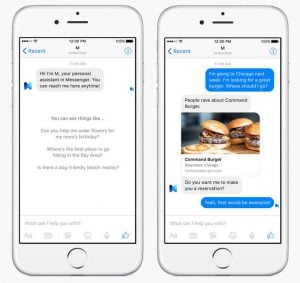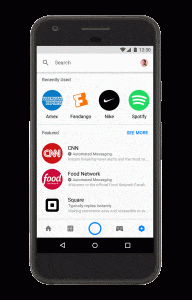Chatbots’ applications in customer care have been heavily discussed in the last few months. After the initial excitement around it, their uses showed mixed results. Some companies managed to adopt it successfully, to bring quick answers and combine it with their agents. Some others developed chatbots degrading customer experience, because of their lack of comprehension and inability to hand over the conversation to a human.
There are a couple of essential key considerations before launching a chatbot, such as:
- when it is relevant in the customer journey?
- what to do when it cannot answer?
To help you better understand chatbots and their potential, we are going through their current applications for customer care.
What is a chatbot?
According to the definition from Chatbots Magazine,
Chatbots are also often compared with apps, as Gartner highlights it in its definition:
Chatbots are often associated with Artificial Intelligence : AI can be used by chatbots, but it is not always the case. Most advanced chatbots use AI and natural language processing (NLP) to understand complete sentences from customers like real humans. Concretely, the interaction with a chatbot looks like a conversation in messaging apps you already know:

Depending on the chatbot technology, the conversation can feature different components:
- Welcome screen: the screen visible by users when they start a conversation, including the name, picture and description of the bot with a greeting text
- Structured messages: this component offers the message recipient options to choose from, for example the action to take, or the nature of his enquiries. This ensures that the chatbot will understand the user.
- Text messages: unlike structured messages, this lets users write complete sentences, that the bot will understand through Natural Language Processing.
Why are chatbots so popular?
In the past few months, every customer care event and media have been talking about chatbots. Several factors can explain this trend:
- The rise of messaging apps: with 2 billion users of messaging apps expected in 2018, messaging is becoming the prefered communication channel of customers. The development of customer care on messaging channels such as Messenger contribute to the development of chatbots. The app now counts more than 100,000 active bots and encourages their development. It has recently launched a “Discover tab”, helping users to discover bots easily:

- Consumers’ expectations for quick answers: consumers are expecting quick answers, forcing companies to improve their response time promise. For basic requests, a properly implemented bot can help match these expectations by providing instant answers, 24/7. According to a study by MyClever, getting quick answers to simple questions and getting 24 hour service are two of the main expected benefits of chatbots.
- The expected cost-saving: by providing automated answers, chatbots can save up agents’ time. Companies can then expect to reduce the associated costs. However, chatbots cannot answer all enquiries and human agents remain essential. Costs associated with a chatbot must be considered as well: the development, its knowledge enrichment, the maintenance, the monthly subscription fee…
- The “hype” effect: with the current trend, several companies want to develop their own chatbots to offer innovative customer experiences. By 2020, 80% of businesses plan to have chatbots. However, to be successful, the implementation of a chatbot must answer to a real customer’s need and be integrated relevantly in his journey.
The main uses of chatbots for customer care
These are some of the main chatbots’ uses for customer service:
- Self care: a chatbot can provide assistance for basic enquiries such as password retrieval, updating personal details… In these cases, the answers are very similar and customers expect a quick treatment. With a chatbot, answers can be standardized, and will be available 24/7. The advantage of this approach is to free up agents’ time so they can focus on more added value tasks.
- Informational purposes: a chatbot can be used to provide information in real time in a more interactive way than other channels. For example, the status of an order or updates on a travel can be sent to customers. In this case, the chatbot must be connected to the company IT system to get the related data.
- Redirection to an agent: a chatbot can be used at the beginning of the interaction to get information from the customer. By asking details such as the nature of the enquiry (technical problem, invoice enquiry…) or the customer number, the chatbot can help qualify the request and redirect to the right channel. When connected to a Digital Customer Interactions Platform, it will then be able to pass the conversation to an agent.
Before launching a chatbot, 3 main issues should be addressed: what will be its perimeter? On which channels will it be implemented? How will it be accessible?
We can see that brands currently launching chatbots for customer care prefer dedicating them to a specific area. For example, electricity provider Direct Energie choose to develop two chatbots: one is dedicated to meter reading, and the other one offers a personalized follow-up to new customers. By limiting their features, the company makes sure it will be able to treat the enquiries received. If needed, the conversation can be handed over to an agent within the platform. This approach is also a good way for Direct Energie to experiment with chatbots and learn from it while keeping its high quality of customer care.
Even if customers do not initiate the conversation with the right chatbot, they can be redirected to them when it’s relevant. Based on criteria such as the message topic, Dimelo’s engine can route enquiries to the right, specialized chatbot.
Chatbots are still at an early phase, and have room for improvement. A study from 3C Interactivereveals that 71% of consumers said the chatbot they interacted with could not answer their question or help them. Companies are also aware of these limitations, as their priority for chatbots is to improve their intelligence and their conversational language (Mindbrowser).
When developing a chatbot, customer experience must remain at the heart of the reflection. It is then essential to rely on messaging channels and a Digital Customer Interactions Platform. This will ensure that the conversation can be handed over to an agent when needed to keep a good customer experience. Such platform will allow to anticipate the development of chatbots on new channels, by making it multichannel. Instead of developing a chatbot for each channel, the existing chatbot can be deployed, making the company save time and development costs.
To sum up, here are some of the main benefits of chatbots in customer service:
- Bringing 24/7 instant answers to basic requests
- Qualifying customer enquiries (question topic, client ID number, etc…) before they are processed by agents
- Freeing up agents’ time, so they can take care of more added value tasks
Originally published Nov 23, 2017, updated Jan 17, 2024





